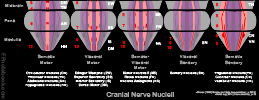II. Definitions
- Brainstem
- Brainstem is the wiring closet of the Central Nervous System
- Brainstem communicates between the spinal cord and the Cerebrum and Cerebellum
- Composed of three segments: Midbrain, pons and Medulla
- Circle of Willis, the interconnected blood supply of the brain, overlies the posterior aspect of the Brainstem
- Contains Cranial Nerve nuclei associated with motor and sensory control of the head and neck
- Traversed by ascending tracts carrying sensory signals from the Peripheral Nervous System to the Cerebrum
- Example: Spinothalamic Tract (carries pain and Temperature sense)
- Traversed by descending tracts carrying motor signals from the Cerebrum to the Muscles.
- Example: Corticospinal tract (carries motor movement signals)
III. Anatomy: Components
-
Midbrain
- Most superior aspect of the Brainstem
- Lies immediately inferior to the Diencephalon
-
Pons Cerebri
- Lies deep to the Pituitary Gland and Circle of Willis
-
Medulla Oblongata
- Immediately superior to the spinal cord
- Lies deep to the clivus (slanted bony surface)
- Lies just above the foramen magnum (hole at skull base)
- With Cerebral Herniation, the Medulla is the first to drop through the foramen magnum
IV. Anatomy: Cranial Nerve Nucleii
- Brain stem Cranial Nerve origins follow a consistent pattern of distribution
- Nucleii are located anterior to the ventricles
- Nucleii are organized in anterior-to-posterior bands
- Images
- Somatic Motor Nucleii (most medial)
- CN 3: Oculomotor Nerve (eye)
- CN 4: Trochlear Nerve (eye)
- CN 6: Abducens Nerve (eye)
- CN 11: Spinal Accessory nerve (neck/Shoulders)
- CN 12: Hypoglossal Nerve (motor, Tongue)
- Somatovisceral nerves (Branchiomeric Nerves)
- CN 5: Trigeminal Nerve (motor nucleus 5, chew)
- CN 7: Facial Nerve (facial nucleus, lips/eyes)
- Nucleus Ambiguous (CN 9, CN 10, swallow)
- Visceral Motor Nucleii
- CN 3: Oculomotor Nerve (Edinger-Westphal Nucleus)
- CN 7: Facial Nerve (Superior Salivatory Nucleus)
- CN 9: Glossopharyngeal Nerve (Inferior Salivatory nucleus)
- CN 10: Vagus Nerve (Dorsal motor nucleus )
- Visceral Sensory Nucleii
- Somatic Sensory Nucleii (most lateral)
- Exceptions
- CN 1 and CN 2 are not included as they originate superior to the Brainstem in the Diencephalon
V. Anatomy: Pass-Through Tracts
- Sensory and motor tracts to and from the extremities pass through the Brainstem without synapsing
- Most of the tracts decusate (cross over the midline) in the Medulla, with two exceptions
- Spinothalamic Tract crosses over the midline within 1-2 levels of spinal cord entry
- Spinocerebellar Tract does not cross over
- Ascending Sensory Tracts
- Spinothalamic Tract (Pain Sensation)
- Spinocerebellar Tract
- Dorsal Columns (proprioception, vibration sense)
- Descending Motor Tracts
- Corticospinal tract
- Corticobulbar Tract
VI. Anatomy: Shared Cranial Nerve Nucleii
- Nucleus Solitarius
- Located in the Medulla, visceral sensory region
- Multiple Cranial Nerve functions
- Nucleus Ambiguous
- Located in the Medulla, somatovisceral region
- Multiple Cranial Nerve functions
- Swallowing (CN 9, CN 10)
- Speech via vocal cord innervation (CN 10)
VII. Anatomy: Images
- High-Level Anatomic Relationships
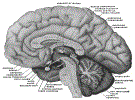 Lewis (1918) Gray's Anatomy 20th ed (in public domain at Yahoo or BartleBy)
Lewis (1918) Gray's Anatomy 20th ed (in public domain at Yahoo or BartleBy) Lewis (1918) Gray's Anatomy 20th ed (in public domain at Yahoo or BartleBy)
Lewis (1918) Gray's Anatomy 20th ed (in public domain at Yahoo or BartleBy)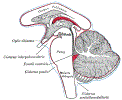 Lewis (1918) Gray's Anatomy 20th ed (in public domain at Yahoo or BartleBy)
Lewis (1918) Gray's Anatomy 20th ed (in public domain at Yahoo or BartleBy) Lewis (1918) Gray's Anatomy 20th ed (in public domain at Yahoo or BartleBy)
Lewis (1918) Gray's Anatomy 20th ed (in public domain at Yahoo or BartleBy)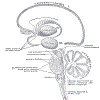 Lewis (1918) Gray's Anatomy 20th ed (in public domain at Yahoo or BartleBy)
Lewis (1918) Gray's Anatomy 20th ed (in public domain at Yahoo or BartleBy)
-
Cranial Nerves Brainstem exits
 Lewis (1918) Gray's Anatomy 20th ed (in public domain at Yahoo or BartleBy)
Lewis (1918) Gray's Anatomy 20th ed (in public domain at Yahoo or BartleBy)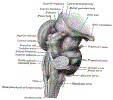 Lewis (1918) Gray's Anatomy 20th ed (in public domain at Yahoo or BartleBy)
Lewis (1918) Gray's Anatomy 20th ed (in public domain at Yahoo or BartleBy)
-
Cranial Nerve Nucleii
 Lewis (1918) Gray's Anatomy 20th ed (in public domain at Yahoo or BartleBy)
Lewis (1918) Gray's Anatomy 20th ed (in public domain at Yahoo or BartleBy) Lewis (1918) Gray's Anatomy 20th ed (in public domain at Yahoo or BartleBy)
Lewis (1918) Gray's Anatomy 20th ed (in public domain at Yahoo or BartleBy)
- Miscellaneous
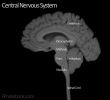
 Lewis (1918) Gray's Anatomy 20th ed (in public domain at Yahoo or BartleBy)
Lewis (1918) Gray's Anatomy 20th ed (in public domain at Yahoo or BartleBy) Lewis (1918) Gray's Anatomy 20th ed (in public domain at Yahoo or BartleBy)
Lewis (1918) Gray's Anatomy 20th ed (in public domain at Yahoo or BartleBy) Lewis (1918) Gray's Anatomy 20th ed (in public domain at Yahoo or BartleBy)
Lewis (1918) Gray's Anatomy 20th ed (in public domain at Yahoo or BartleBy) Lewis (1918) Gray's Anatomy 20th ed (in public domain at Yahoo or BartleBy)
Lewis (1918) Gray's Anatomy 20th ed (in public domain at Yahoo or BartleBy) Lewis (1918) Gray's Anatomy 20th ed (in public domain at Yahoo or BartleBy)
Lewis (1918) Gray's Anatomy 20th ed (in public domain at Yahoo or BartleBy) Lewis (1918) Gray's Anatomy 20th ed (in public domain at Yahoo or BartleBy)
Lewis (1918) Gray's Anatomy 20th ed (in public domain at Yahoo or BartleBy) Lewis (1918) Gray's Anatomy 20th ed (in public domain at Yahoo or BartleBy)
Lewis (1918) Gray's Anatomy 20th ed (in public domain at Yahoo or BartleBy) Lewis (1918) Gray's Anatomy 20th ed (in public domain at Yahoo or BartleBy)
Lewis (1918) Gray's Anatomy 20th ed (in public domain at Yahoo or BartleBy)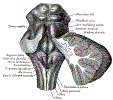 Lewis (1918) Gray's Anatomy 20th ed (in public domain at Yahoo or BartleBy)
Lewis (1918) Gray's Anatomy 20th ed (in public domain at Yahoo or BartleBy) Lewis (1918) Gray's Anatomy 20th ed (in public domain at Yahoo or BartleBy)
Lewis (1918) Gray's Anatomy 20th ed (in public domain at Yahoo or BartleBy)
VIII. Pathophysiology
IX. Signs: Brain Lesions
- Cranial Nerve dysfunction
- Ataxia
- Papillary abnormalities
- Nystagmus
- Hemiparesis
- Autonomic Dysfunction
X. References
- Gilman (1989) Manter and Gatz Essentials of Neuroanatomy and Neurophysiology, Davis, p. 81-96
- Goldberg (2014) Clinical Neuroanatomy, Medmaster, p. 24-39
- Netter (1997) Atlas Human Anatomy, ICON Learning, p. 108-12
- Newton (1994) Am Fam Physician 49(4): 787-97 [PubMed]

